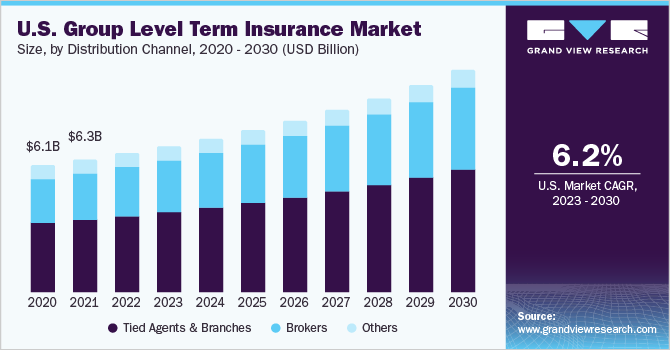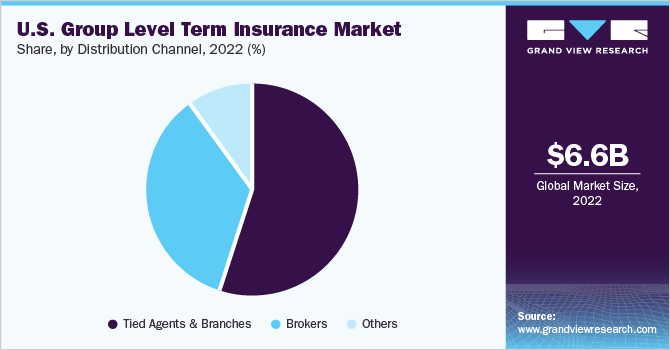- Home
- »
- Next Generation Technologies
- »
-
U.S. Group Level Term Insurance Market Size Report, 2030GVR Report cover
![U.S. Group Level Term Insurance Market Size, Share, & Trends Report]()
U.S. Group Level Term Insurance Market Size, Share, & Trends Analysis Report By Distribution Channel (Tied Agents And Branches, Brokers), And Segment Forecasts, 2023 - 2030
- Report ID: GVR-4-68040-050-6
- Number of Report Pages: 80
- Format: PDF, Horizon Databook
- Historical Range: 2017 - 2021
- Forecast Period: 2023 - 2030
- Industry: Technology
Report Overview
The U.S. group level term insurance market size was valued at USD 6.63 billion in 2022 and is expected to grow at a compound annual growth rate (CAGR) of 6.2% from 2023 to 2030. The need for financial security among employees, increasing healthcare costs, employer-sponsored benefits, and an aging population are some of the prominent attributes contributing to the market's growth. As healthcare costs continue to rise, many employees seek ways to protect their financial security in the event of an unexpected illness or death. Moreover, group term-level insurance provides a cost-effective way for employees to obtain coverage, often at a lower cost than individual policies.In addition, employer-sponsored benefits are becoming increasingly important as companies seek to attract and retain top talent. Group term level insurance is often included in these benefit packages, providing employees with peace of mind and financial security while also enhancing their overall compensation package.

Another key driver of the U.S. group term level insurance industry is the aging population. As the baby boomer generation approaches retirement age, many are looking for ways to protect their financial security and ensure that their loved ones are taken care of in the event of their death. Group term level insurance is an affordable way to achieve this goal, allowing older Americans to obtain coverage at a reasonable cost.
The flexibility and ease of administration of group level term insurance are also significantly contributing to the market growth. Group policies are typically easy to administer, with employers handling most of the paperwork and premium payments. In addition, group policies can be tailored to meet the specific needs of different organizations. This allows employers to offer affordable and comprehensive coverage.
Another driver of these market is the increasing demand for voluntary benefits. Many employees are looking for additional coverage beyond their employer-sponsored plans, and group level term insurance can provide a cost-effective way to obtain this coverage. Voluntary plans allow employees to purchase coverage at discounted rates, often with no medical exam required. Furthermore, many insurance companies are using technology to streamline the underwriting process and make it easier for employees to obtain coverage. Online applications and electronic signatures have made it faster and more convenient for employees to enroll in group policies. At the same time, predictive analytics and data mining are used to improve underwriting accuracy and reduce costs.
However, the lack of awareness and understanding among employees regarding the importance and benefits of having such coverage is restraining the market growth. Many employees may not fully understand the risks they face and may not be aware of the financial protection that group level term insurance can provide for their families in the event of their death or unexpected illness. To overcome this restraint, insurers and employers can focus on education and communication efforts to raise awareness of the importance of group level term insurance and its benefits. This can include offering educational seminars or webinars, distributing informational materials, and providing one-on-one consultations with employees to help them understand their options and make informed decisions.
COVID-19 Impact Analysis
The COVID-19 pandemic has significantly impacted the U.S. group level term insurance market, supporting its market growth in several ways. The pandemic has highlighted the importance of having financial protection in the event of unexpected illness or death. Many employees have become more aware of the risks they face and the need for financial security, leading to an increase in demand for group level term insurance. Furthermore, the pandemic has increased the importance of employer-sponsored benefits, as many employees have faced financial challenges and uncertainty.
Distribution Channel Insights
The tied agents and branches segment dominated the market in 2022 and accounted for a revenue share of more than 55.0%. This is partly due to the complex nature of group level term insurance policies and the need for personalized guidance and advice during the enrollment process. Agents and branches are able to provide this level of support and guidance to employers and employees, helping them to navigate the enrollment process and select the coverage that best meets their needs. In addition, agents and branches are able to build relationships with employers and employees, providing ongoing support and assistance throughout the life of the policy.

The brokers segment is anticipated to register the fastest growth over the forecast period. The growth is attributed to the fact that brokers are able to offer a wide range of products from multiple insurance carriers, giving employers and employees access to a broad range of coverage options. This has made brokers an attractive distribution channel for employers and employees, driving segment growth and making group level term insurance more accessible to a broader audience. With the continued growth of the broker channel, it is likely to play an increasingly important role in the distribution of group level term insurance over the projected period.
Key Companies & Market Share Insights
To maintain their competitive edge and provide inventive solutions to clients, leading players are actively pursuing strategic endeavors like mergers and acquisitions, as well as forming partnerships. These initiatives demonstrate their commitment to staying ahead of the competition. For instance, in December 2021, MetLife partnered with YuLife, a tech-driven insurance company, to underwrite its group life cover policies. YuLife provided a tech-driven solution that leveraged gamification and behavioral science while MetLife offered its extensive underwriting expertise.
In May 2020, Prudential Group Insurance, a division of Prudential Financial, Inc., enhanced its group benefits process by partnering with several companies to offer smoother, real-time, and personalized interactions. These partnerships include a new program from PlanSource to enable instantaneous data sharing and formal agreements with benefits administration technology providers, such as Businessolver and Empyrean, to deliver an enhanced user experience and integration with existing HR platforms. Through these partnerships, Prudential aims to make it easier for employers and employees to manage benefits. Some of the prominent players in the U.S. group level term insurance market include:
-
MetLife
-
Prudential Financial, Inc.
-
Lincoln National Corporation
-
Unum Group
-
New York Life Insurance Company
-
Voya Services Company
-
United Healthcare Services, Inc.
-
Securian Financial Group, Inc.
-
Reliance Standard Life Insurance Co.
-
The Guardian Life Insurance Company of America
U.S. Group Level Term Insurance Market Report Scope
Report Attribute
Details
Market size value in 2023
USD 6.96 billion
Revenue forecast in 2030
USD 10.57 billion
Growth rate
CAGR of 6.2% from 2023 to 2030
Base year of estimation
2022
Historical data
2017 - 2021
Forecast period
2023 - 2030
Quantitative units
Revenue in USD million/billion and CAGR from 2023 to 2030
Report coverage
Revenue forecast, company market share, competitive landscape, growth factors, and trends
Segments covered
Distribution channel
Key companies profiled
MetLife; Prudential Financial, Inc.; Lincoln National Corporation; Unum Group; New York Life Insurance Company, Voya Services Company; United Healthcare Services, Inc.; Securian Financial Group, Inc.; Reliance Standard Life Insurance Co.; The Guardian Life Insurance Company of America
Customization scope
Free report customization (equivalent to up to 8 analysts working days) with purchase. Addition or alteration to country, regional & segment scope
Pricing and purchase options
Avail customized purchase options to meet your exact research needs. Explore purchase options
U.S. Group Level Term Insurance Market Report Segmentation
The report forecasts revenue growth at country levels and provides an analysis of the latest industry trends in each of the sub-segments from 2017 to 2030. For this study, Grand View Research has segmented the U.S group level term insurance market report based on the distribution channel.
-
Distribution Channel Outlook (Revenue, USD Million, 2017 - 2030)
-
Tied Agents and Branches
-
Brokers
-
Others
-
Frequently Asked Questions About This Report
b. The U.S. group level term insurance market size was estimated at USD 6.63 billion in 2022 and is expected to reach USD 6.96 billion in 2023.
b. The U.S. group level term insurance market is expected to grow at a compound annual growth rate of 6.2% from 2023 to 2030 and is expected to reach USD 10.57 billion by 2030.
b. The tied agents and branches segment accounted for the maximum share of 55.2% in 2022. This is partly due to the complex nature of group-level term insurance policies and the need for personalized guidance and advice during the enrollment process.
b. Some key players operating in the banking system software market include Metlife; Prudential Financial, Inc.; Lincoln National Corporation; Unum Group; New York Life Insurance Company; Voya Services Company; United Healthcare Services, Inc.; Securian Financial Group, Inc.; Reliance Standard Life Insurance Co.; and The Guardian Life Insurance Company of America.
b. Key factors that are driving the U.S. group level term insurance market growth is the need for financial security among employees, increasing healthcare costs, employer-sponsored benefits, and an aging population.
Share this report with your colleague or friend.
![gvr icn]()
NEED A CUSTOM REPORT?
We can customize every report - free of charge - including purchasing stand-alone sections or country-level reports, as well as offer affordable discounts for start-ups & universities. Contact us now
![Certified Icon]()
We are GDPR and CCPA compliant! Your transaction & personal information is safe and secure. For more details, please read our privacy policy.
We are committed towards customer satisfaction, and quality service.
"The quality of research they have done for us has been excellent."





